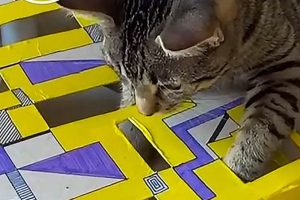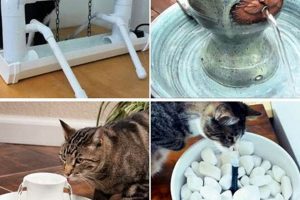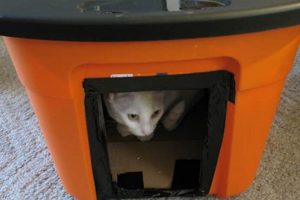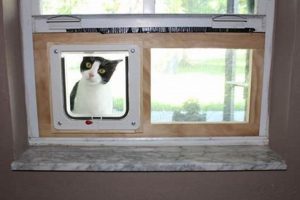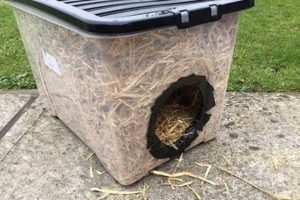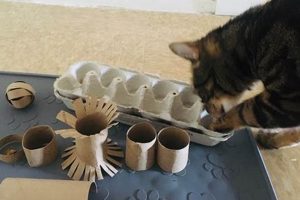The construction of weatherproof housing for felines unable to reside indoors, utilizing readily available materials and basic tools, represents a tangible expression of compassion for vulnerable animals. These structures provide refuge from inclement weather and potential predators, offering a measure of security for feral or stray cats. Considerations typically involve insulation, weatherproofing, and accessibility for the intended occupants.
Providing protection from the elements for outdoor cats is a vital undertaking with direct positive impact on animal welfare. The availability of these shelters minimizes the risk of hypothermia, frostbite, and other cold-weather related ailments. Furthermore, such initiatives contribute to the overall health and well-being of feline populations by offering a safe haven during periods of vulnerability, thereby promoting increased survival rates.
The following discussion will explore various design options, material considerations, and construction techniques pertinent to the creation of effective and durable shelters. Emphasis will be placed on practical solutions achievable with minimal resources and readily obtainable supplies.
Key Considerations for Shelter Construction
Optimizing feline habitation necessitates careful planning and execution. The following guidelines should be observed to ensure the creation of effective and lasting structures.
Tip 1: Size and Spatial Requirements: The shelter must accommodate at least one cat comfortably, allowing sufficient room to turn around and lie down. Overly large shelters may be less effective at retaining heat.
Tip 2: Insulation is Crucial: Employing insulating materials, such as rigid foam insulation boards or straw, will significantly improve the shelter’s ability to maintain a stable temperature. Avoid fiberglass insulation, which can be harmful if ingested.
Tip 3: Weatherproofing Imperative: All exterior surfaces require robust weatherproofing to prevent water infiltration. This may involve the application of waterproof paint, tarps, or shingles to exterior surfaces.
Tip 4: Entrance Design Matters: A small entrance (approximately 6-8 inches in diameter) will deter larger animals and minimize heat loss. Consider an offset or covered entrance to further protect against the elements.
Tip 5: Material Selection Considerations: Durable, weather-resistant materials, such as plastic storage bins, plywood, or repurposed wood, are preferable. Avoid materials that absorb water or are prone to rot.
Tip 6: Elevated Positioning Beneficial: Raising the shelter slightly off the ground on bricks or wooden blocks prevents moisture buildup and provides additional insulation from the cold ground.
Tip 7: Bedding Choices: Straw is an excellent bedding option, providing insulation and allowing cats to burrow. Avoid blankets or towels, which can become damp and freeze in cold weather.
Adherence to these principles will result in shelters offering enhanced protection and comfort for their intended occupants. Meticulous construction contributes significantly to improving the well-being of feral and stray feline populations.
The subsequent sections will delve into specific design examples and provide detailed construction instructions.
1. Weatherproof construction
Weatherproof construction is an indispensable component of any outdoor cat shelter intended to provide refuge from the elements. Effective weatherproofing safeguards against moisture, wind, and temperature extremes, directly impacting the health and survival of feline inhabitants.
- Material Selection
The selection of appropriate materials forms the foundation of weatherproof construction. Materials like durable plastics, treated lumber, or corrugated metal offer inherent resistance to water damage and degradation. The use of absorbent materials such as untreated wood or cardboard is ill-advised due to their susceptibility to moisture retention and subsequent decay, which compromises the integrity of the shelter.
- Sealing and Insulation
Sealing all seams, joints, and entry points is crucial for preventing water infiltration. Silicone caulk or waterproof sealant can effectively close gaps and create a barrier against rain and snow. Insulation further enhances weatherproofing by minimizing temperature fluctuations within the shelter and preventing condensation, which can lead to dampness and mold growth. Closed-cell foam insulation or straw provide effective insulating properties without absorbing moisture.
- Roof Design and Overhang
The design of the roof significantly influences its weather-resistance capabilities. A sloped roof facilitates water runoff and prevents pooling, reducing the risk of leaks. An overhang extending beyond the walls of the shelter provides additional protection by shielding the entrances and sides from direct rainfall. The effectiveness of a roof design is directly correlated to the level of protection afforded against water intrusion.
- Elevated Base
Raising the shelter off the ground using bricks, wooden blocks, or a dedicated platform prevents water from seeping into the structure from below. This elevation also reduces the risk of insect infestation and minimizes the effects of ground moisture, further contributing to the shelter’s overall weatherproof integrity. Direct contact with the ground increases the likelihood of water damage and temperature fluctuations, both detrimental to the health and comfort of the inhabitants.
These considerations, collectively, underscore the importance of weatherproof construction within the broader context of providing safe and effective shelter for outdoor cats. Thoughtful material selection, meticulous sealing, strategic roof design, and elevated positioning all contribute to creating a dry, secure environment that protects feline populations from the adverse effects of harsh weather conditions. A properly weatherproofed shelter significantly increases the chances of survival and improves the overall well-being of outdoor cats.
2. Insulation effectiveness
The measure of a shelter’s capacity to maintain a stable internal temperature, independent of external conditions, is crucial to its utility. For structures built under the “outdoor cat shelter diy” ethos, insulation effectiveness directly determines the degree of protection afforded against hypothermia in winter and overheating in summer. Inadequate insulation renders a shelter functionally useless, as it fails to mitigate the environmental stressors it is intended to alleviate. For example, a shelter constructed solely of thin plywood, devoid of any insulation, will quickly reflect ambient temperatures, offering negligible respite from extreme cold or heat. Conversely, a well-insulated structure utilizing materials such as rigid foam board, straw, or recycled textiles can maintain a temperature differential of several degrees, providing a habitable microclimate.
Effective insulation necessitates a comprehensive approach, encompassing the selection of appropriate materials, the elimination of drafts, and strategic placement of the shelter. Closed-cell foam, renowned for its thermal resistance and moisture impermeability, stands as a superior choice for insulation compared to open-cell alternatives, which can absorb moisture and lose their insulating properties. Careful attention to detail, such as sealing gaps around doorways and windows with weather stripping, further enhances insulation effectiveness by preventing convective heat loss. The strategic placement of the shelter in a sheltered location, shielded from prevailing winds and direct sunlight, can also significantly improve its thermal performance. The cumulative effect of these measures directly enhances the shelter’s capacity to provide a stable, protective environment.
In conclusion, insulation effectiveness is not merely a desirable attribute, but rather a fundamental requirement for a successful “outdoor cat shelter diy” project. Its impact extends beyond mere comfort, influencing the survival rates and overall well-being of feral and stray cats. While the challenges of achieving optimal insulation may vary depending on available resources and construction skills, the underlying principle remains constant: a well-insulated shelter is a life-saving refuge.
3. Predator deterrence
Predator deterrence constitutes a critical element within the realm of outdoor cat shelter construction. The presence of natural predators, such as coyotes, foxes, and larger birds of prey, poses a significant threat to vulnerable feline populations, particularly kittens and weakened adults. Shelters designed without adequate predator deterrence mechanisms can inadvertently become traps, offering minimal protection against determined predators. The success of any “outdoor cat shelter diy” project hinges, in part, on its ability to mitigate these risks. A shelter, for instance, with a single, large opening invites entry by larger animals, negating its intended purpose.
Practical application of predator deterrence principles involves several strategies. One common approach utilizes a small entrance hole, typically 6-7 inches in diameter, which allows feline access while restricting larger predators. A tunnel-like entrance further reduces the likelihood of a predator successfully reaching inside. Raising the shelter off the ground can also deter some ground-based predators. Structural integrity plays a role; the shelter must be robust enough to withstand attempts by predators to access its occupants. Material choices are equally important. Durable plastics or reinforced wood offer greater resistance than flimsy cardboard. A multi-chamber design provides cats with a secure retreat further inside the structure.
In summary, effective predator deterrence is not an optional feature, but a mandatory component of a responsibly constructed outdoor cat shelter. The integration of these deterrent strategies, from entrance design to material selection, directly influences the safety and survival of the cats utilizing these shelters. While no shelter can guarantee absolute protection, implementing these measures significantly reduces the risk of predation, contributing to the overall well-being of feline populations and fulfilling the core objective of a “outdoor cat shelter diy” undertaking.
4. Cost efficiency
Cost efficiency, as it pertains to outdoor cat shelter construction, constitutes a central tenet for widespread adoption and effective resource allocation. Limited financial resources often necessitate creative and pragmatic solutions, directly impacting design choices and material selection.
- Repurposed Material Utilization
The strategic reuse of discarded items represents a primary avenue for cost reduction. Examples include utilizing discarded plastic storage bins, reclaimed wood pallets, or surplus insulation materials. Such practices reduce reliance on newly purchased components and minimize environmental impact, simultaneously achieving economic and ecological benefits.
- Simplified Design Schematics
Complex architectural blueprints necessitate specialized skills and increased material expenditures. Employing simplified design schemes, such as basic A-frame structures or modified box designs, minimizes construction time and reduces the demand for specialized tools. This approach maximizes utility while minimizing the financial investment.
- Community Resource Collaboration
Pooling resources and collaborating with local community organizations, animal welfare groups, or volunteer networks can significantly alleviate individual financial burdens. Shared procurement of materials, collaborative construction efforts, and donated supplies contribute to reduced overall costs and increased project scalability.
- DIY Skill Acquisition
Developing basic carpentry skills and acquiring proficiency in fundamental construction techniques empowers individuals to perform the majority of the work independently, thereby eliminating labor expenses. Online tutorials, community workshops, and instructional guides provide accessible pathways for acquiring these skills, promoting self-sufficiency and reducing reliance on external contractors.
These facets collectively underscore the significance of cost efficiency within the landscape of outdoor cat shelter construction. The judicious application of these principles not only expands the accessibility of such initiatives but also promotes sustainable practices and fosters community engagement, ultimately contributing to the improved welfare of feline populations.
5. Accessibility
Accessibility, within the context of constructing shelters for outdoor cats, directly influences usage rates and, consequently, the overall effectiveness of the endeavor. A shelter that is difficult to enter or navigate poses a significant barrier, particularly for elderly, injured, or very young felines. This can negate the intended purpose of providing refuge from the elements and predators. The ease with which a cat can enter, exit, and maneuver within the structure dictates its practicality as a viable shelter option. For instance, a shelter with a steep entrance ramp may be unusable for a cat with arthritis, while a dark, confined interior may deter a skittish or feral animal. The design must prioritize ease of access to maximize its benefits to the intended recipients.
Practical application of accessibility principles involves several considerations. Entrance size is a crucial factor; while a small opening deters larger predators, it must still be large enough to comfortably accommodate the cats in question. Low thresholds and level ground surrounding the entrance facilitate ease of entry. Interior layout should be simple and uncluttered, allowing cats to turn around and settle comfortably. The use of non-toxic, low-odor materials is also essential to avoid deterring cats with sensitive senses of smell. Location plays a vital role as well; shelters should be placed in areas readily accessible to cats, away from heavy foot traffic and potential disturbances. An improperly placed shelter, even with an ideal design, may remain unused if it is perceived as unsafe or difficult to reach.
In summary, accessibility is not a secondary consideration, but an integral component of successful outdoor cat shelter construction. Prioritizing ease of access ensures that the shelters are readily utilized by the intended recipients, maximizing their value in providing protection and comfort. Addressing potential barriers through thoughtful design, material selection, and strategic placement is crucial to the overall effectiveness of these initiatives, fostering the well-being of vulnerable feline populations. Overlooking accessibility can render even well-intentioned efforts futile.
Frequently Asked Questions
This section addresses common inquiries concerning the construction and deployment of outdoor cat shelters. The information presented aims to provide clarity and guidance for individuals seeking to provide safe and effective refuge for feral and stray felines.
Question 1: What is the optimal size for an outdoor cat shelter?
An outdoor cat shelter should be appropriately sized to accommodate the number of cats it is intended to house. An excessively large shelter can dissipate heat, rendering it less effective in cold weather. Conversely, an overly small shelter may be uncomfortable. A general guideline is to provide approximately 2 cubic feet of space per cat.
Question 2: What materials are most suitable for insulating an outdoor cat shelter?
Effective insulation materials include rigid foam board, straw, and mylar blankets. Avoid materials that absorb moisture, such as fiberglass insulation or cotton batting. Damp insulation loses its thermal properties and can create a breeding ground for mold and bacteria.
Question 3: How can an outdoor cat shelter be effectively weatherproofed?
Weatherproofing requires sealing all seams and joints with waterproof caulk or sealant. Ensure the roof is sloped to facilitate water runoff and extends beyond the walls to prevent rain from entering. Elevated placement on bricks or a wooden platform also minimizes moisture intrusion.
Question 4: What measures can be taken to deter predators from accessing an outdoor cat shelter?
Implement a small entrance, typically 6-7 inches in diameter, to restrict access to larger animals. A tunnel-like entrance further reduces the likelihood of a predator successfully reaching inside. Ensure the shelter is constructed of durable materials that can withstand attempted breaches.
Question 5: What type of bedding is recommended for an outdoor cat shelter?
Straw is the preferred bedding material, as it provides excellent insulation and allows cats to burrow for warmth. Avoid blankets and towels, which can become damp and freeze in cold weather.
Question 6: Where is the optimal location to place an outdoor cat shelter?
Locate the shelter in a sheltered area, away from prevailing winds and heavy foot traffic. Position it against a building or under a tree to provide additional protection from the elements. Ensure the location is easily accessible to the cats it is intended to serve.
The information provided in these frequently asked questions represents a starting point for understanding the complexities of outdoor cat shelter construction. Further research and adaptation to specific environmental conditions are encouraged for optimal results.
The subsequent section will address advanced design considerations for specialized shelter configurations.
Conclusion
The preceding exploration of outdoor cat shelter diy underscores the multifaceted nature of this undertaking. From material selection and insulation techniques to predator deterrence and strategic placement, each element contributes to the efficacy of the final product. Successful implementation requires a synthesis of practical skills, resourcefulness, and a commitment to improving the well-being of vulnerable animals.
As communities continue to grapple with the challenges posed by feral and stray cat populations, responsible construction of outdoor shelters represents a tangible and impactful solution. The principles and practices outlined herein offer a foundation for individuals and organizations seeking to create safe, sustainable havens. Continued innovation and collaborative efforts will undoubtedly yield further advancements in this important field, ensuring the long-term welfare of feline communities.


